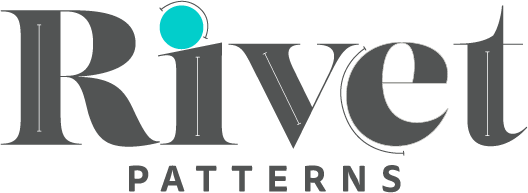In this post, we're talking about a High Round Back Adjustment. High round back is exactly what it sounds like. This is increasingly common in our tech era, bending over keyboards and phones. This adjustment goes hand in hand with the Forward Shoulder Adjustment. You may find you need one or the other, or both.
If your tops/dresses slide back on your shoulders, and your neckline is constantly creeping up on you, this may be the answer you need! A high round back increases the measurement of the center back (from the little bone at the base of the neck to the natural waistline).
First, we're going to talk about making a small adjustment of less than 1" that requires no darts. This will also create a center back seam. If you'd like to follow along with me on video, you can find it HERE on our YouTube channel.
Step one, as nearly always, you'll need to draw in your seam allowances wherever you will be making a hinge. In this adjustment, add the SA at the neckline, shoulder line, and armscye. If your bodice is on the fold, you do not need to do anything there. If your bodice already has a center back seam, you will need to draw in the seam allowance and then REMOVE it all together.

Draw your first line a half inch or so from below the neckline seam allowance, to the top portion of the armscye. If you are adding 1/2" or less, one line is sufficient. If you are adding 1/2"-1", draw a second horizontal line approximately 6" below the first one - to the bottom 1/3 of the armscye. Cut the horizontal line(s) from the center back to the seam allowance line at the armscye. Cut to, but not through, the seam allowance at each pivot point, giving you hinges.

Keeping the body of the bodice in place, spread the top(s) of the hinge(s) upwards, to create length in the upper center back. If you are adding just a small amount, you may be able to keep the bodice on the fold (if it was originally). In most cases, you'll be creating a lengthened curve to the upper back.

Last, you'll redraw your center back seam, and add the seam allowance back on to the center back seam. If your bodice was previously on the fold, you will now cut this piece as two mirror images. That's all there is!

Our second method includes adding darts. If you are adding 1-2", the previous method is going to end up distorting the center back significantly. Which is fine, if that doesn't bother you, however adding darts will mitigate that distortion by adding darts in one, two, or even three places. If you would like to follow along with me on video, you can view it HERE on YouTube.
Before you begin, remove any of the seam allowances on the bodice piece, including center back (if applicable). Usually I just have you draw them in, but it's easier to add darts without them.
Draw the first line horizontally from the center back to the armscye, approximately 2/3rds of the way down the armscye. Draw a second line from approximately the middle of the neckline, down to the first line, at a slight angle. If you are adding a larger amount (or want more darts to distribute width), draw a 3rd line from the mid shoulder down to where the first two lines intersect.

Cut the first (horizontal) line you drew from the center back to the armscye. Cut to, but not through, the armscye, making the first hinge. Next, cut from the neckline down to the intersection. Again, cut to, but not through, making the second hinge. We are going to leave the last (red) line alone for right now.

Draw yourself a a guideline for the center back (or use a straight ruler). Gently slide piece A upwards while rotating piece B outwards by the amount you wish to add. Keep the top of piece A against the guideline, creating a gap at the neckline. This gap is where you will draw a three legged dart, equally distributed. You will then redraw the center back (using the guideline), add the seam allowances, and true the dart. If this dart is all you need, then you're done! If the dart seems big, or you need to add more, keep going!

To distribute the big dart, you can make two smaller darts. Pivot piece A towards the armscye to close the neckline dart by the amount you wish. This will move the top center back portion of piece A away from the guideline. Remember that this dart will be centered on the guideline so it will become double the width when cut on the fold. Draw in the darts at the neckline and center back. You will then redraw the center back (using the guideline), add the seam allowances, and true the dart. If these two darts work for you, you're done! If you would like to add even more, or distribute the darts even more, keep going.

The last way to add a dart is with the unused (red) line through piece B. You will cut from the shoulder line down to the intersection. Cut to, but not through, keeping the hinge intact.

Just as in the previous steps, we will move piece A up and pivot towards the armscye. Piece B will pivot slightly towards the armscye, and our new piece C will do the same. Having 3 hinges allows you to add more space if necessary, and distribute the added space between more darts (making them smaller). You could also choose to eliminate the center back neck dart, and use only the neck and shoulder darts. Whatever works best for you! When you are happy with your pattern piece, draw in the darts. You will then redraw the center back (using the guideline), add the seam allowances, and true the dart. That's it!

Happy Making!
Rachelle

